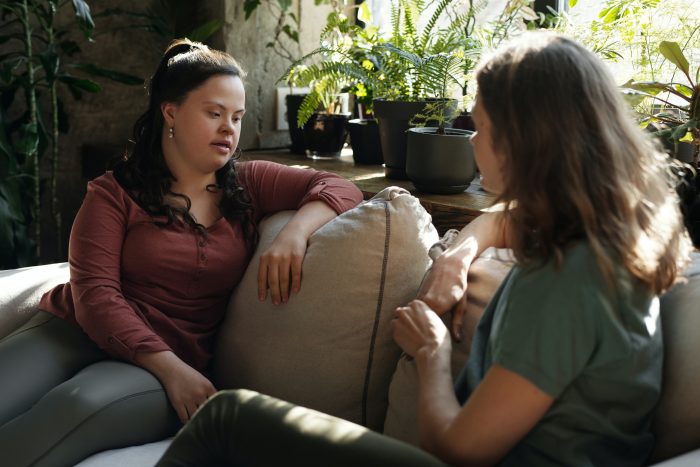For years, my friends and I have learned to hold space for each other whenever we wanted to share something personal and emotionally difficult.
By holding space, I mean being there for each other in an open and accepting way, without judgment, or advice-giving, and without using the other’s story as a springboard to dive into our own.
Up until recently, however, I never thought about drawing on simple yoga practices to help hold space. But this summer, in a Zoom-enabled yoga sanctuary, our teacher, Leslie Ellis, asked us to hold space for each other as a regular part of our week-to-week practice. In doing so, we intentionally involved our body and breath, drawing on basic yogic principles of alignment and energy flow.
I’d like to share what I’ve learned about a body-centered approach to holding space. My hope is that what I’ve experienced might also have meaning for others who see the value of holding space, but who may not have consciously brought the breath and posture into the practice yet.
Sitting Back
The most basic way I’ve come to hold space is to roll back on my sitting bones—the bones under the flesh of the butt—as I sit facing my friend, ’til I’m balanced on my bones and I’m sitting up tall.
This may seem like a small thing, but it’s not so small when contrasted with my usual practice, which is to lean forward toward the other, so that I’m not grounded in my sitting bones but lifting up slightly from them. In this orientation, my head and torso are angled away from my center, toward my friend, and I’m rocking forward on my seat.
My intention in leaning forward, I suspect, is to show my eagerness to hear what the other person has to say. But this intention has an unintended effect, and that is to jut myself into the space that I’m trying to hold open for my friend. My angling-in body is occupying territory that would remain open if I were to rock back on my sitting bones, feel my central balance, and sit upright.
Opening the Palms
This is an action that my yoga-teaching friend Catherine offered. What Catherine was referring to is the practice of opening the palms and forearms in a posture of receiving.
Opening the palms is in itself a welcoming action. It also has a kind of ripple effect in which energy travels up into the shoulders and invites them to roll up and back.
What I find is that when my palms, arms, and shoulders are rolling open, my heart naturally begins to lift and open, too. It’s as if my heart is receiving a trusting signal from my outer structure to take inside what my friend is saying.
Breathing into the Back Body
In my early years of yoga practice, I emphasised breathing into my belly, that is, letting my belly naturally bulge out on the inhale. This helped me breathe more deeply, smoothly, and less superficially, with fewer fits and starts.
Belly breathing definitely has its place, but I’ve found that if I just focus on this, I tend to move my energy out and in front of me. In the context of holding space, an emphasis on bulging the belly outward is like leaning forward. It tends to fill space between my friend and me that would be better left open.
When holding space, rather than escorting my breath into a belly bulge, I’ve found it helpful to breathe into my back body. My belly still expands a little, but the breath doesn’t stop with this front-body expansion. Instead, when I invite my breath into my kidneys and into the back of my heart, I feel a rise and expansion of my whole inner core. I feel more centered and open to myself. This back-body breathing is a complement to sitting back on my sit bones—it steadies me and supports sitting up tall, with the front and back of my rib cage in balance.
It may seem paradoxical that engaging my back body with my breath helps me to hold space for another. But if I’m not balanced and centered within myself, it’s hard to be present for a friend.
Softening the Eyes
Looking at a friend with a soft gaze rather than a sharply focused one is another way to create an inviting space. A soft gaze happens when we allow our eyes to settle back into their sockets, and we relax the muscles that surround the eyes. Breathing into the area behind and around the eyes can help to release tension.
With a soft gaze, our focus is relatively wide and open. It allows us to take in what’s happening in our peripheral vision and not just what’s straight in front of us. A soft gaze offers a relaxed visual presence. It says: “I’m curious about and receptive to whatever is going on for you.” In contrast, a more narrow and tightly directed gaze says: “I’m requesting, perhaps even challenging you, to tell me something I want to know about. And please stay on track.”
There’s a parallel between leaning forward and gazing sharply, and sitting back and gazing softly. The former is a more assertive energy that carries expectations for the other. The latter is a more receptive energy that makes no assumptions about what the other person should say or how they should say it.
Sliding the Head Back
Finally, a sweet action that seems like a culmination of the other actions described above is to slide my head back and let the crown of my head naturally rise toward the sky. The cue that works best for me when I think about moving the head back is to “slide my ear lobes back.”
In the context of holding space for another, when my head slides back, as distinct from tilting forward, it’s as if my head is taking the back seat to make room for my friend’s feelings to take the front seat.
Holding space is a mutually affirming act of friendship. When we intentionally involve our breath and our body in the practice, it becomes even more meaningful and vital.












Read 9 comments and reply